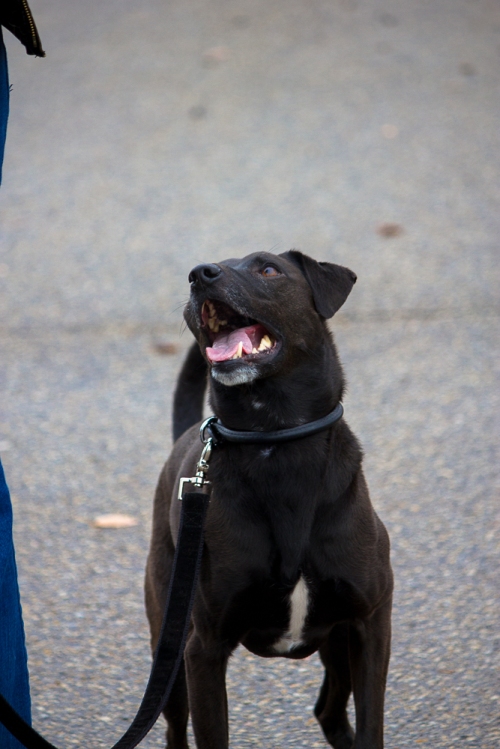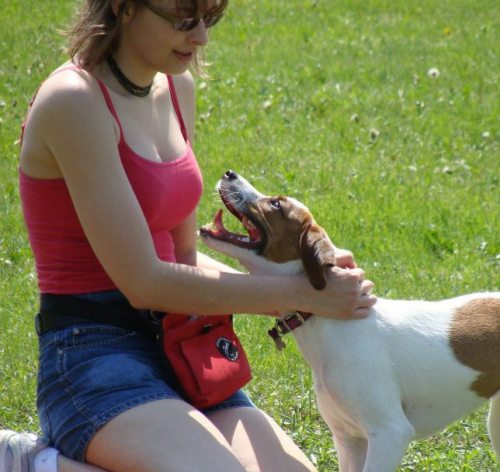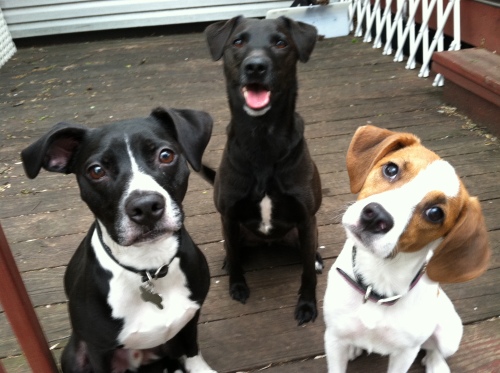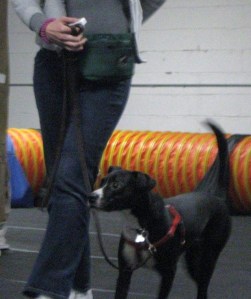 Seven years ago yesterday, I adopted Layla. Since then, she has been my friend, my muse, my inspiration, and my confidant. She has pushed me to tears and made me laugh so hard it hurt. She moved across the country and back with me. I love her so much it hurts. The light in her eyes makes me happy. The journey with her hasn’t been easy, but it’s been worth the frustration and fear and expense a million times over. I’m so glad she’s my dog, and that I’m her person.
Seven years ago yesterday, I adopted Layla. Since then, she has been my friend, my muse, my inspiration, and my confidant. She has pushed me to tears and made me laugh so hard it hurt. She moved across the country and back with me. I love her so much it hurts. The light in her eyes makes me happy. The journey with her hasn’t been easy, but it’s been worth the frustration and fear and expense a million times over. I’m so glad she’s my dog, and that I’m her person.
Happy Gotcha Day, Layla!
Filed under Layla, Uncategorized
Missing Layla: the dangers of xylitol poisoning
(Crossposted from my other blog.)
Even with Dobby and Mischief asleep next to me, my house feels empty today. It’s easy to take what you have for granted until it’s not there, and today I’m missing Layla like crazy. I’m lucky that this isn’t a permanent loss, but only a temporary one. Layla is spending the weekend at the emergency vet clinic, and the house is empty without her.
Layla was lucky. Last night, she got into a pack of gum containing xylitol, an artificial sweetener. Had I not caught her eating the pack and recognized the danger, things may have turned out very differently. My house might have been empty forever. Just the thought of losing her feels like a physical blow.
Xylitol is an artifical sweetener frequently used in sugarfree gum, candies, and baked goods. It has some oral health benefits for people and is frequently used as a sugar substitute for people who cannot have real sugar. It’s also highly toxic to dogs.
Even a small bit of xylitol can cause dangerous drops in blood sugar. The first symptoms of xylitol poisoning are oftentimes vomiting, glazed eyes, weakness, lethargy or depression, and ataxia (balance issues). These can be followed by seizures and coma. Larger doses can lead to hypokalemia (decreased potassium) and liver failure.
As soon as I found Layla eating the gum, I gave her hydrogen peroxide to induce vomiting. While my other two dogs both threw up, Layla didn’t, and was rushed to the e-vet where they were finally able to get her to vomit about 45 minutes after she ate the gum. By that time she was feeling poorly enough to be cooperative with several strangers handling her, inserting a catheter and taking blood.
As of this afternoon, Layla’s prognosis is good. Her glucose and liver values are great, and she’s being kept on fluids and continually monitored. If she continues to do well, she can come home Sunday evening or Monday morning.
Layla was lucky. She was lucky that I recognized the danger soon enough to get her treated before she began showing serious symptoms. She was lucky to have a great veterinary team ready to help her. She was lucky that I have enough in savings to cover her treatment and hospitalization so that she could get the care she needs. She was lucky that she’s otherwise strong and healthy.
Not every dog is as lucky as Layla.The number of cases of xylitol toxicity continues to climb each year as this ingredient becomes more common as a sugar substitute. Many dogs don’t make it. Poisoning from other common human foods, including chocolate, grapes, raisins, macadamia nuts, and onions are also sadly too common.
It’s empty in my house today, but it won’t be forever. Layla was lucky, and she will be coming home. Please make sure to keep toxic substances out of reach of your pets so that you, too, can continue to enjoy the company of your best friend for many years to come.
Filed under Layla
The Joy of an Uncomplicated Dog
Mischief is an amazingly uncomplicated dog. This worried me when I adopted her. Would I be bored? Would the anxiety issues of my other two dogs create issues for her? Would living with Layla be fair to her? And again, would I be bored?
I’m very used to fixing dogs. Putting together behavior plans, working on carefully structured protocols, and keeping track of triggers and threshold distance have become second nature for me. I love special dogs. Reactive dogs, fearful dogs, anxious dogs, excitable dogs, aggressive dogs, and misunderstood dogs of all sorts have a special place in my heart. An uncomplicated dog? A just-plain-doggy dog? Now that was confusing!
And yet, I’m kind of getting used to the idea of not fixing. Of just… being. This isn’t to say that Mischief is perfect. She can be environmentally sensitive, and still struggles with mild separation and light-chasing issues. However, these aren’t issues that require more than the tiniest bit of management and awareness. Issues that a normal pet owner could readily deal with. Issues that, well, aren’t really an issue.
Mischief is uncomplicated. She’s sweet and joyful. She likes dogs and people. She likes my other dogs. She likes me. And I kind of like all of this.
I just dropped her off at daycare. She was happy to go – she enjoys hanging out with the other dogs. We walked calmly into the building. She checked in with me every few steps, just a little glance, a wiggle, and a quick wag of her stump. She kept her leash loose after one reminder, a quiet “this way” on my part. When she was let in with the other dogs, she greeted everyone calmly and sweetly with polite sniffing, then settled beside an elderly Golden Retriever. No drama, no fuss. Just… easy.
I love Layla and Dobby with all my heart. I love them for who they are, flaws and all. But I’m finding that I also love Mischief for her simpleness. Everyone needs a little lightness and joy in their life. Not worrying is liberating. An uncomplicated dog isn’t boring after all, but rather relaxing. Like a cool breeze on a muggy summer day, Mischief is just what I need.
Filed under Choosing a Dog, Dog Selection, Mischief, Rescue
Listening to Your Heart
I recently adopted a puppy.
I wasn’t looking for a third dog. I have my hands full with Layla and Dobby, who both have behavioral issues that require a large amount of training and management. In fact, there were a lot of really great reasons why I shouldn’t have adopted this dog, and I argued with myself about them for weeks. And yet, somehow, she ended up staying.
That’s right. Not only is this puppy nothing like my other dogs in personality or appearance, she’s also a female. Layla doesn’t have a problem with female puppies, but often dislikes adult female dogs. And yet, somehow, I kept this puppy anyway. Where many, many foster puppies have come and gone, she came and stayed.
I’m not generally an impulsive person. I have a life plan, a careful budget, and definite “rules” about when I felt I would be ready to bring a third dog home (hint: it wasn’t for another five years or so). Mischief came home and turned all of this upside-down within a few short weeks. Suddenly, I couldn’t imagine life without her. She smoothed into our household as if she’d always been here.
Was keeping her the right choice? I don’t know. Only time will tell. However, I do know that I haven’t felt this depth of connection since I met Layla. I felt the same instant, inexplicable tug with baby Layla, and couldn’t imagine my life without her. Layla’s brought me on an incredible journey. It certainly hasn’t been easy, and there have been times where I’ve felt like I was in over my head. I cared for Dobby from the start, but it took nearly a year to develop that deeper connection with him that happened instantly with both girls. I can remember looking at Dobby as he snuggled in my arms one morning months after I’d adopted him and thinking, “You’re my dog now.”
So’s Mischief. She’s my dog now, and so far the four of us are getting along splendidly. Here’s hoping that my heart was as smart as my head. I’m not used to listening to it, but when it spoke up so strongly I could do nothing else.
Welcome home, puppy.
Filed under Choosing a Dog, Dobby, Dog Selection, Layla, Mischief, Rescue
The Best Teachers
I failed my dog this weekend.
That’s not a very cheerful way to start a blog post, and I’m afraid this post doesn’t paint me in a very positive light. However, I think the topic is important enough to write about even if I do find the situation quite embarrassing. So without further comment, here’s what happened.
This weekend, I attended a seminar by a well-known clicker trainer. I pick which seminars to go to quite carefully, and was so excited about this one. This particular author was one of the first to write clearly about such important concepts as shaping and the Premack principle, and her explanations were timely in my personal development as a professional trainer. I was so pumped that I managed to secure a working spot for Dobby on Sunday.
You can imagine my disappointment, then, when I began to realize that this trainer’s shaping style differed significantly from mine. It was interesting to watch this person work. She has impeccable mechanical skill, and is clearly incredibly talented. Many of her approaches parallel my own, and the initial working slots in the seminar were a joy to watch. She introduced the cardboard box game to teach dogs to offer behavior, and the working dogs all dived into this game with enthusiasm.
Things started to break down later in the morning, when those working dogs were put into problem solving spots. This seminar presenter uses free shaping to deal with problem behaviors, which I also sometimes do (although for the sake of transparency I’m much more likely to use a Control Unleashed game, such as Give Me a Break, at this point). My comfort level plummeted, however, when I watched the amount of pressure that was put on the dogs during these exercises. It was clear that our tipping point for when to “push the envelope” was quite different.
I watched as the working dogs were put in situations where the message was, “if you succeed, I will make you more uncomfortable.” It’s absolutely important to raise criteria as a dog is successful, but after one successful trial (with success defined, not by the dog’s expression or emotional state, but rather by their ability to offer an acceptable behavior or respond to a known cue), these dogs would be asked to go back into the same situation as one of the criterion was bumped up a notch. The author spoke at length about negative reinforcement, but despite the great opportunities available to make use of this principle by taking pressure off the working dog as a reward for an acceptable response, this technique was not utilized. Dogs responded slowly. Dogs disengaged and zoomed. Dogs stress-sniffed. I had to leave the room at one point, as a little Papillon was so uncomfortable about being asked to slam a teeter board that every line of her body communicated uncertainty and hesitation.
Understand here, this trainer does not force dogs to do anything. She free shapes, which means the dog is always allowed to say “no” with no consequence other than the lack of a click and treat. These dogs were in no way corrected for disengaging. However, the amount of pressure put on them was phenomenal. In each case, the dog clearly understood what was expected of him or her. Dogs who left the working space were recalled or put on leash (not to use the leash to coerce the dog into responding, simply to prevent the dog from leaving again). However, just because the dogs weren’t forced to respond does not make the amount of pressure placed on them okay. These dogs were not happy, and they were not having a good time. They were learning that when they felt uncomfortable they could not depend on their owners to help them feel better about the situation.
With all of this to consider, I spoke to the presenter on Saturday afternoon. I introduced myself and told her that I had a working spot the next day and that I was hesitant about the amount of pressure being placed on the working dogs, as I felt it would be harmful for my working dog to be placed in such a situation. She told me she would be happy to work with me on adjusting criteria for my individual dog, and that I could just let her know if I felt we needed to change anything for him. I was reassured and decided to keep Dobby’s working spot.
I skipped the lecture on Sunday morning, as I had found it so aversive to watch the working dogs on Saturday that I couldn’t face the idea of watching another full day of stressed dogs. Sunday afternoon was our working spot, and I approached it with mixed feelings. I was reassured that the presenter would be willing to adjust criteria for him, but worried that I would be put into the tough spot of disagreeing with a so-called expert in front of my friends and colleagues. In retrospect, I should have listened to my gut feeling and given up my working spot, as there was a waiting list of dogs whose owners would have been thrilled to be given the opportunity to work.
When asked what my goal for Dobby was, I told the presenter that I wanted him to find joy in working in this situation. I knew that this goal was attainable for him, as he’s been in higher-criteria settings (such as rally trials) where he had a wonderful time and looked confident and happy. I explained that he could be neophobic and was sometimes fearful of unfamiliar people, especially men or people in hats.
The presenter’s goal for Dobby was the same as mine: she wanted unfamiliar or scary things or people to become a cue for Dobby to pay attention to me. Our paths for reaching that goal, however, differed significantly, and this is where the first big issue appeared. Up until now, I have treated these situations as “Look at That” opportunities, using the Control Unleashed game. If Dobby was unable at any point to quickly turn back to me and instead began staring, I would use the Whiplash Turn to break his stare and would back further away from the trigger until he was comfortable enough to quickly turn back to me.
The presenter wanted me to shape his attention instead, and I expressed concerns about changing the rule structure for him at this point in his training. This is where this post becomes somewhat embarrassing to share. In spite of my attempts to be nonconfrontational and respectful, I clearly did a poor job of explaining our current training protocol. At one point, the presenter sarcastically told me, “well, since you clearly know everything…” when I asked that we tweak her training plan, and I could feel my skin flush as I thought of everyone watching this uncomfortable exchange. She asked me why I signed up if I didn’t want to follow her recommendations, and I again did a poor job of explaining that while I was very interested in her suggestions (why else would I have spent the extra money for a working spot?), I was concerned that they would put too much pressure on my dog and wanted to make sure that he felt happy and comfortable during his working sessions rather than concerned.
I wanted Dobby to know that I would keep him safe, not just physically, but emotionally as well. My dogs are my friends and companions first and foremost, and while I do compete with them I refuse to put competitive goals before our friendship. I want my dogs to know that they can trust me to not just keep them safe, but to only ask them to do things that make them happy. If they do not find joy in a chosen sport, I will not ask them to continue going into that situation. When I’m holding that same dog in my arms ten or fifteen years from now as the vet inserts the needle to end their life, I’m not going to be looking back and thinking of all the titles or awards that dog has won, but rather of the quality of the time we spent together. I don’t ever want to look back with regrets.
Anyway, back to the seminar. Dobby was asked to heel in a circle around a man, and I was to reward him for focusing on me. I clicked him for quick glances at the man, playing the Look at That game, but agreed to wait him out if he began to stare, then click when he reoriented to me on his own. In retrospect, this was a poor idea. On several different occasions, Dobby began to stare at people who concerned him, getting locked into a negative spiral. The longer he stared, the more uncomfortable he felt, and the more uncomfortable he felt, the more he needed to stare. To add fuel to the fire, I felt myself torn between trying to talk with the presenter or other auditors who had questions and trying to support my dog. I was unable to give him 100% of my attention, and I know he felt the disconnect. It was a poor setup.
The pictures from the seminar tell the true story of what happened. Dobby is nothing if not willing, and he tried his best for me. He has not always been like this, but with the deep relationship we’ve built up over the past year his desire to follow my lead has blossomed. It’s a lot of responsibility to have a dog who will try his heart out like this, and I feel like I failed him this weekend by taking advantage of his willingness. My little dog did absolutely everything I asked of him, and had I done a better job of listening I would not have asked so much. Pictures show him trotting in heel position, his face a picture of concern. There was no joy in his performance.
After our second of three working sessions, I felt like crying. Dobby’s behavior was deteriorating, and he was doing more and more staring as his discomfort increased. I also felt like I was being put on the spot and made to look stupid, and was very uncomfortable with the thought of having to go up in front of the crowd of auditors in such a socially uncomfortable setup again.
I decided to change our plan, and during our last working session I instead asked the presenter about a different issue, Dobby’s overarousal during tug sessions. To be honest, this issue is already well on its way to being resolved. Using the Premack principle, I’ve been able to shape Dobby to eat in the presence of a tug toy, and then later to “out” the toy on cue. We’ve done a large amount of zen work with the toy, and Dobby is able to heel over and around multiple toys and treats on the ground with confidence. However, I was very interested in the presenter’s approach to this issue, and also wanted to give Dobby the chance to play tug in this setting as I knew that he felt more confident and less concerned when he was playing than when he was asked to work solely for food treats.
The last session went much more smoothly, and I was happy to find that the presenter’s approach to this issue was very much in line with what I had already done. Her suggestions of when to click and when to raise criteria were very helpful. More importantly, Dobby did not feel the need to scan or stare and was engaged in the game.
This weekend was a huge learning experience for me, and I value it for the important lessons I learned. After I left the seminar, I parked my car and cried for five minutes, a result of the embarrassment and stress of the day. People have thresholds too, and I was well past mine. Several days later, I still have a negative reaction to the thought of the seminar. I learned some important lessons, most especially to listen to my instincts and to protect my dog’s trust in me at all costs, but the lesson came with its own fallout. It may be a long time before I consider working my dog with an unknown seminar presenter again.
What about Dobby? He went home and slept hard, and woke up the next day none the worse for wear. I haven’t seen any residual signs of stress with him like I would with Layla, who typically takes three days to recover from stressful situations. It amazes me how much heart and courage this little dog has, and I’ve resolved to respect and honor that in the future. It’s not easy to face one’s fears, and Dobby never stopped trying for me last weekend. He slept on my lap for awhile today, curled up with his head on my shoulder, and I couldn’t help but think of the terrified little “pancake” dog of just over a year ago, who would have hit the ground and peed all over himself had I asked him for even 1/10 of what I asked him for this weekend. He’s by no means “cured” (or even, to be honest, safe to put in many situations), and honestly never may be. But he keeps trying, and he keeps getting better, and the journey together only serves to make me love him more. We’re both okay, and I appreciate everything that makes this earnest, silly, amazing little dog so unique.
Training seminars and working with experts can be great, but they’re not everything. My best teachers have always been my dogs, and if I can only keep listening to them, they’ll continue to teach me. May I always be as devoted a student as they are.
Tribalism in Dog Training: One Trainer’s Perspective
There’s been a lot of hate speech about other dog trainers (especially those who use traditional techniques) on various email lists lately, so I thought I would share my personal philosophy and recent experiences as another perspective.
 I’m a clicker trainer, and don’t believe that the use of force or coercion is ever necessary (with dogs OR people). I do not permit choke, shock, or prong collars in my classes and help people find alternative ways to control and train their dogs. I believe in managing a dog’s environment and access to reinforcement and in shaping behaviors I like. Although my business offers pet dog and competition classes, the majority of my personal time is spent working with dogs who have serious behavior issues.
I’m a clicker trainer, and don’t believe that the use of force or coercion is ever necessary (with dogs OR people). I do not permit choke, shock, or prong collars in my classes and help people find alternative ways to control and train their dogs. I believe in managing a dog’s environment and access to reinforcement and in shaping behaviors I like. Although my business offers pet dog and competition classes, the majority of my personal time is spent working with dogs who have serious behavior issues.
We have a wide variety of trainers practicing locally, using a wide variety of techniques. My policy regarding other trainers is 100% R+ – I never say anything bad about another trainer, no matter how much I may disagree with them. I will explain why I don’t recommend a specific method to a client who asks me about it (or is currently using it), but I will not denigrate the trainer who recommended that method. Ever.
Is this hard? You bet. Sometimes I cringe at the advice my local colleagues give. Sometimes I feel that their techniques are uncalled for, or even inhumane. I may call another R+ colleague and vent, but in front of anyone else, I am never less than professional. I will address a technique if asked, but I will not address the professionalism or knowledge of the person who recommended that technique. When asked about a technique I disagree with, I acknowledge that there are many different ways to effectively train a dog, then tell the person who’s asking what I would do, and why. I tell people that any local dog trainer can probably help them accomplish their goals as long as they stick with it and follow that person’s advice, but that I believe my techniques will be the fastest, most effective, and most resistant to extinction over time. I use clicker training because I believe it works best, end of story.
So, here’s the thing: none of the local trainers are evil dog-hating psychopaths. As much as some clicker trainers may want you to believe that anyone who doesn’t use clicker training is cruel and loves hurting dogs, that’s just not the case. There’s a lot of tribalism in dog training, and I’m calling bullshit. Every trainer I know loves dogs. Some believe that the best way to train dogs is using prong collars or e-collars or alpha rollovers, but they do this because they believe that’s the best way to work with the animal in front of them. They do not do this because they hate dogs.
I know that if someone accused me of abusing dogs, I would be highly offended. I would never, ever want to speak to (or even be around) that person again. I really don’t blame some traditional trainers who speak badly of clicker trainers. If someone who happens to use e-collars starts to look into clicker training because she’s curious, and she gets treated like she’s an evil baby-eating Nazi because her dog has an e-collar on, is she likely to continue learning? Maybe, if she has a thicker skin than I do. But if that was me, and the roles were reversed, I would never again leave my comfort zone.
I believe in being positive with dogs and people. And you know what? This works. I invite any local trainer, regardless of the methods they use, to come audit any class I teach. I’m happy to go out to lunch with them and to talk dogs. I’m genuinely interested in learning more about their techniques, and ask for book and DVD recommendations (I find I always learn something, even if the techniques are not those I would personally choose to use or recommend). I’m happy to lend them books or DVD’s from my personal library, and to talk about said books and DVD’s. I invite them to read and comment on my business’s blog. I don’t preach, and, while it’s human nature to judge, I keep any judgements to myself.
You know what else? Being nice works. Tonight, I had the first of four private in-home sessions with a lovely couple and their young dog. These people were referred to me by a local e-collar trainer. I came home and exchanged emails with a student who’s interested in agility lessons with her dog, and is currently training at the local facility where prong collars are included in the cost of any beginning class’s tuition. I bought ring gates from another local e-collar trainer, and currently have an old-school trainer who uses Koehler methods auditing my classes. I regularly refer clients to the other local CPDT’s when I get too busy to take in new clients.
So, here’s my call to action for all professional dog trainers: let’s stop the hate speech. Whether your method of choice is clicker training, e-collars, lure/reward, or dominance theory, please treat your colleagues with respect. Please don’t be afraid to ask questions of others whose training philosophy doesn’t mirror your’s, and to learn more. You may not agree, and that’s okay. No, really, it’s okay.
There are a lot of dangers to dogs today. Puppy mills, irresponsible owners who treat their pets as throw-away commodities, breed-specific legislation, anti-dog legislation, radical groups like the HSUS and PETA, inbreeding and the threat to genetic diversity, overbreeding of Pit Bulls and “something-Poos,” unnecessary medical procedures like surgical debarking or ear cropping, law enforcement’s use of lethal force against dogs, and many other topics of are much greater concern to the animals we love and work with than what other professional dog trainers are doing. We can do more good for dogs as a united front than we can with our petty squabbling about the best way to teach a recall. Can’t we all just get along?
Filed under Training
Advocating for the Anxious Dog
Working on behavior cases such as aggression and anxiety can be incredibly rewarding. There’s nothing like watching the bond between a dog and owner deepen as both learn to trust one another and work cooperatively together. Seeing a fearful dog blossom or an anxious dog learn to relax always gives me goosebumps.

Both of these dogs required behavior modification to deal with fear and anxiety issues. One of them (Layla) also required anxiety medication.
Working with behavior cases can also be incredibly frustrating and devastating at times, and nowhere is that more likely than when the subject of anxiety medications comes up. This is probably the biggest area, other than the dangers of punishment, where I meet client resistance and misconceptions. Perfectly reasonable people become perfectly unreasonable when I bring up the topic of seeing a veterinarian or veterinary behaviorist to discuss medicating their dog. This has to stop, for the dogs’ sakes.
Imagine that your dog is diagnosed with hypothyroidism. This means that his thyroid gland is not working as well as it should, and because of this physical problem he is suffering from a range of symptoms (possibly lethargy, weight gain or loss, poor temperature regulation, and skin/coat issues, to name a few). The vet prescribes daily medication to regulate his thyroid levels. Would you refuse to give him this medication?
Now, let’s say your dog is diagnosed with diabetes. His body can no longer regulate his blood sugar levels, and due to this physical problem he’s suffering from a range of symptoms, including excessive drinking, excessive urination, increased appetite, and weight loss. The vet prescribes insulin injections to regulate his blood sugar levels. Would you refuse to give him his insulin shots?
What if your dog is diagnosed with anxiety? His brain chemistry is imbalanced due to too little serotonin. Due to this physical problem he’s suffering from a range of symptoms such as hypervigilance, trouble sleeping restfully, irritability, and reassurance-seeking behaviors. Your vet prescribes a Selective Serotonin Re-uptake Inhibitor (SSRI) to increase the amount of serotonin in his brain. Would you refuse to give him this medication?
Here’s a news flash: anxiety is often a physical issue. The brain is an organ. As such, it can develop abnormally (in utero or due to early experiences), suffer from physical trauma, or malfunction. There is a delicate chemical balance that can sometimes, due to genetics or environment, get disrupted. We know that the brain of a dog who was given a supportive, enriched environment as a puppy is physically different from the brain of a dog kept in a sterile environment or exposed to traumatic or neglectful stimuli during development. We know that the brains of anxious or aggressive animals are observably different from those of normal animals. This is not news. This is a fact that has been proven time and time again through rigorous scientific study.
We treat other physical problems with a combination of lifestyle changes (management) and medication. Severe anxiety needs to be treated the same way. Not treating an anxious dog due to your personal misconceptions about anxiety medications is just as neglectful as not treating your dog’s diabetes or hypothyroidism. We may treat a severe heart arrhythmia by giving a dog beta blockers and limiting strenuous physical activity. Severe anxiety is best treated with both medications and behavior modification. One or the other given separately just doesn’t cut it in many cases.
So why are so many people resistant to using anxiety medication for their dogs?
There’s a large cultural bias against anxiety, for one. Because the symptoms are less quantifiable than, say, a kidney problem, it’s harder to definitively diagnose anxiety. There is still a large portion of the population who seem to believe that anxiety does not really exist. This is sad and harmful.
The brain has an amazing capacity to heal itself and return to homeostasis, which I think also causes some people to become resistant to the use of meds. It’s true, there are many cases where dogs really don’t need medication and just behavior modification alone will fix the problem. Through learning, new neural pathways can be created and the problem behavior may resolve. This is why I almost never recommend anxiety medications as the first step when working with behavior cases. However, I would say that overmedication is much more rare than undermedication in our society, and overmedication is often used by vets and owners looking for a “quick fix” without behavior mod – which is doomed for failure.
The bottom line is this: not every case needs anxiety medication. In fact, the majority of cases don’t. However, some cases legitimately do. In these cases, refusing to consider medication is as cruel and neglectful as refusing to give pain medication to a dog with severe hip dysplasia. If your dog’s quality of life is impacted by severe anxiety or aggression, you owe it to her to help her. You owe it to her to consult with a board certified veterinary behaviorist about medication.
You are her voice. Advocate for her. Do not make her suffer because of your misconceptions.
I Believe
As a professional dog behavior consultant, I often talk to people who are struggling and frustrated. They often share facts with me that make me cringe, whether it be details about the e-collar they’ve been using to shock their fearful dog every time he growls or the fact that they’ve been rubbing their anxious dog’s nose in his urine each time he marks while yelling “no” at him.
In addition to dog training, I also work closely with rescue. Dogs come into rescue who have been starved, beaten, or left on a chain. People surrender dogs for reasons that seem ridiculous to me, only to turn around and get a new puppy. Some people view their dogs as disposable.
Regardless of the details a person shares with me, I try not to judge. This is easier to say than to do some days. The 7 sentences below hang above my workspace to remind me of my principles.
I believe that there is more positive than negative in the world.
I believe that the majority of people are good and kind.
I believe that abuse, neglect, and negativity are born of fear or lack of education.
I believe that I have no right to judge others, as I don’t know what battles they may be facing.
I believe that I can help more by listening than by talking.
I believe that I can make a difference in the world, one good deed at a time.
I believe that positive energy will return to me threefold.
Your Dog
 To the person who abandoned your elderly Lab in Rochester two months ago;
To the person who abandoned your elderly Lab in Rochester two months ago;
I wanted to let you know what happened to your dog.
Your dog was found as a stray. I can’t imagine he ran away. His hips didn’t work so well anymore.
Your dog spent two weeks at the pound, lying in his own feces on the cold concrete. He was sad, scared, and very confused.
When it became clear that you weren’t coming for him, I took your dog home. I bathed him and took him to the vet.
I gave your dog good food, clean water, and soft beds to lie on. I gave him a new name because I didn’t know what you had called him for the last 10-15 years of his life.
I walked your dog every day. He could only go to the end of the block, but it made him so happy. He danced when he saw the leash.
When the pain meds were no longer enough, I took your dog to the vet one last time.
I held your dog on my lap, all 105 pounds of him, and stroked his head. I told him that he was a good boy. I told him that he was loved. I stayed with him as he died.
To the person who abandoned your elderly Lab 2 months ago, I wanted to let you know that your dog was a good dog. Your dog missed you. Your dog forgave you for abandoning him in his final days.
I’m not as good of a person as your dog was, but I will try to forgive you too.
I wanted to let you know that your dog had 43 days of love and compassion with me.
I wish he could have been with you during those twilight days. He had a lot of lessons to teach you still. I’m so very sorry you missed out on them.
Note: thank you to Camp Companion for covering Paddy’s vet bills and helping his final days to be spent with dignity.
Filed under Rescue
Everybody is a Genius
I hated high school. Throughout my school career, I always got excellent grades. I never caused trouble. My teachers mostly liked me. I had wonderful friends (many of whom I still keep up with today). I was miserable.
I felt bored and frustrated in class, and missed school as often as possible. I never cut school – I wasn’t going to get in trouble – but stayed home “sick” as often as I could get away with it. I was later diagnosed with a legitimate autoimmune disease, but quite honestly quite a few of my “sick days” in high school were really just “can’t stand to sit in a desk and be bored” days. I would miss whole weeks of school. I never fell behind in my schoolwork. I would spend a couple hours studying, writing papers, and filling out worksheets, then spend the rest of the day reading, surfing the internet, or playing video games. I would do anything to avoid feeling trapped in that desk, listening to the same material repeated over and over again.
Looking back at my high school career, a few bright spots stand out. Most notable were a small handful of teachers who made a profound difference.
Mr. Behrens, my sixth-grade teacher, listened to my ideas and assigned me different books to read when he found out that I’d already read the book the class was studying.
Mr. Snyder, my band teacher, wrote special passes to get me out of study hall so I could practice my flute in the tiny, echoey rooms behind his office (and looked the other way when my friends, who also had practice passes, would all cram into one little room together to play occasional cut-throat games of Scrabble).
Mrs. Dix, who came after him, kept up the practice passes and never flinched when I told her I wanted to play an incredibly complicated piece of music with 64th and 128th notes in it for competition.
Mrs. Gehrking, an A.P. English teacher, continued to expand my literary horizons with exciting and challenging work, keeping the class to a fast pace that encouraged me to attend class in order not to fall behind.
Most teachers, however, stuck to the established worksheets, rote learning, and tests. They expressed frustration at my poor attendance and seemed insulted that I didn’t participate more than half-heartedly in class. When I asked to earn extra credits towards graduation for very complicated work I had done (and documented) with color genetics in dwarf hamsters, I was told that such a thing probably wasn’t possible and given empty praise by a teacher who didn’t care to look further into the issue. In 7th grade, my English teacher told me that she would have cast me in the lead role of Titania in “A Midsummer Night’s Dream” since my audition was one of the best, but decided against it due to my poor attendance (I was instead given the role of Philostrate, who has 2 lines in the entire play).
So, how does this relate to dog training? I believe that the same characteristics that make me remember certain teachers with fondness or frustration are the characteristics that shape our dogs’ training relationships with us.
When I look back at my school career, the teachers who became my favorites were those who both valued and challenged me. They never gave me challenges I couldn’t succeed at, but always pushed me slightly past my comfort zone. They paid attention to my interests and skills, and nurtured those abilities. They were honestly interested in me and in what I could do, and because of this I was willing to work much, much harder for them. Even when they gave me much more work than I was given in other classes, I didn’t mind because it was work I enjoyed and was excited to complete.
When I look at my students’ dogs, I notice the same trend. Those students who support their dogs, who play to their natural strengths, who listen to and adjust to their dogs’ individual personalities: these are the students who have happy, willing dogs. Students who challenge their dogs, setting them up for success in training but always pushing slightly, these are the students whose dogs are the most excited to work. By taking note of their dogs’ interests and inserting them into a training program, these people develop a true partnership with their pets that others can only grasp at.
Clicker training is a partnership. It can’t be done with an unwilling dog. Sometimes though, this is what ends up happening. By relying on formulaic training plans (“first you do X, then Y”) or pre-conceived notions (“all dogs love to work for hot dogs” or “all agility dogs must play tug”), we can forget to listen to what our dog is telling us. We can lose sight of what makes the dog in front of us special.
When we forget to look for brilliance, we see only mediocrity.
Every dog is an individual. Just because your last dog enjoyed working for food doesn’t mean that this one wouldn’t prefer to play. While the channel method may have worked brilliantly to teach your last dog to weave, this dog may do better with 2×2’s. Dobby was initially too frightened to follow a lure, but learned to sit and down within a week by capturing these behaviors. Layla enjoys heeling practice where I stride out and make her work hard to keep up; Dobby still goes over the top if I move this quickly. Dobby does better with very light, cheerful verbal corrections if he’s starting to make a mistake, while the same feedback would make Layla anxious (and thus, more likely to repeat the mistake).

Layla's high prey drive, which could be considered an inconvenience in conventional dog sports, makes her a phenomenal lure courser.
My parents and I didn’t know about other options, such as an alternative art school or Post Secondary education, when I was in high school, and the overworked guidance counselor certainly wasn’t concerned about looking too closely at a student who was passing all her classes. I sometimes wonder how I would be different had I had a more supportive environment where I was free to engage in self-paced study and explore my interests. Just because that may have been a good fit for me doesn’t mean that my old school should change their curriculum though. Every student is different, and my recipe for success could very well have been another student’s worst nightmare.
I’m reminded of a quote by Albert Einstein: “Everybody is a genius. But if you judge a fish by its ability to climb a tree, it will live its whole life believing that it is stupid.”
Are you judging your dog by his ability to climb a tree when you could be focusing on how well he can swim? Time to change perspectives. Everybody is a genius. We just need to focus on their brilliance and help their light shine through.
Filed under Choosing a Dog, Genetics, Rescue, Training






